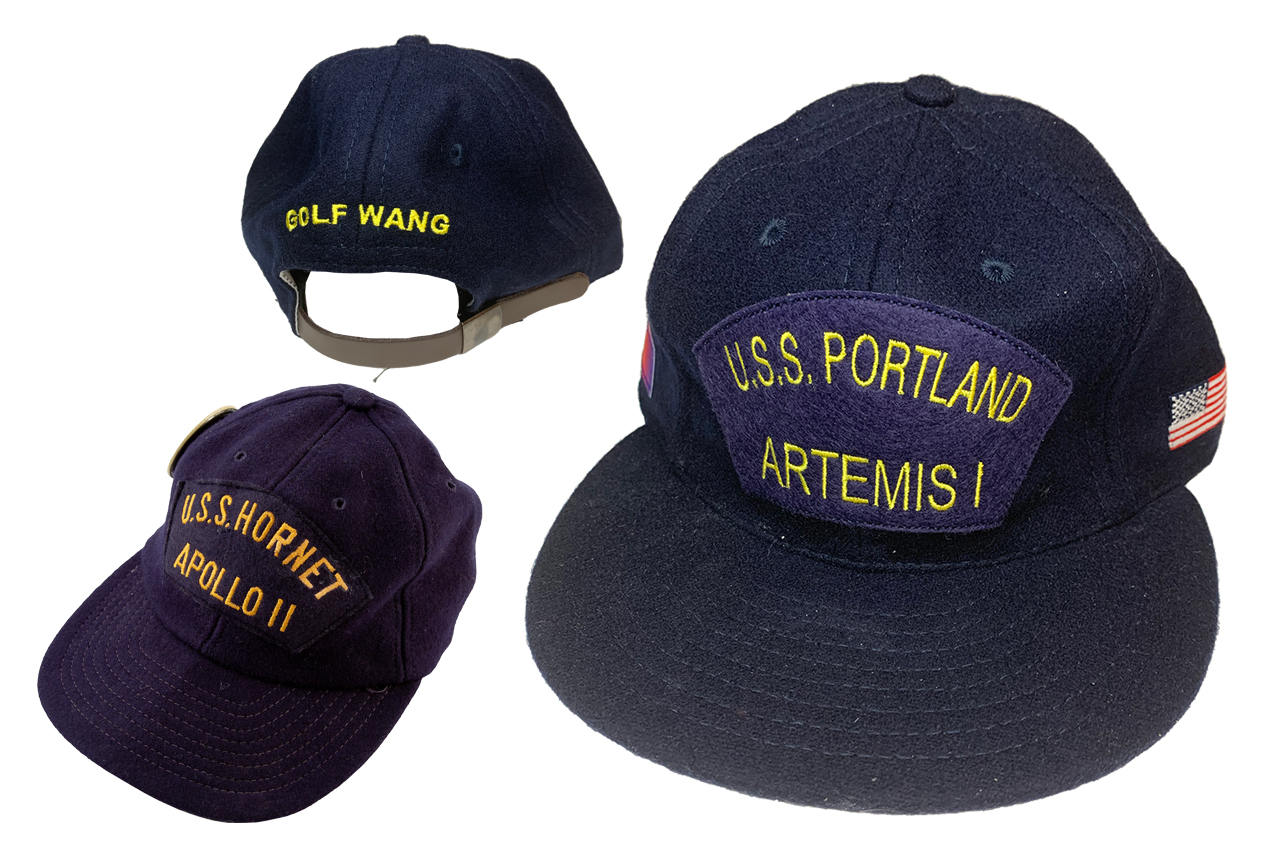NASA's TV coverage of Artemis 1 recovery included 'hat tip' to Apollo

There was something familiar about the hat NASA commentator Derrol Nail wore as he stood on the deck of the USS Portland and described the scene on Sunday (Dec. 11) as NASA's Orion spacecraft splashed down from the moon. Not by accident, Nail's blue ballcap evoked images of Apollo astronauts as they arrived aboard their own recovery ships 50 years ago.
Nail's hat was made to be part vintage replica, part modern fashion design. On its front panel, the cap was embroidered with "USS Portland" and the name of the NASA mission being recovered, "Artemis I." The panel was similar in style to those on the caps that were available on board the U.S. Navy ships that recovered the Apollo crews.
"We pulled a lot from that inspiration, knowing that we needed to create something specific for the team who were going to be part of the recovery," said Jeff Jetton, co-founder and CEO of Oxcart Assembly, the advertising and marketing agency contracted by NASA to develop a new look for the agency's Artemis TV coverage.
The cap diverged, though, from being a replica beginning with its side panels. On one side was a small American flag; on the other, a gradient colorway that Oxcart developed to represent NASA's new horizon.
Related: NASA's revolutionary Moonboard launched Artemis 1 coverage to new heights
As Nail turned away from the camera to look out over the water, viewers saw the cap's designer label — Golf Wang. Part of Oxcart's team for the NASA project, Golf Wang is musician Tyler, the Creator's streetwear brand established in 2011.
"I think that this was a very unique opportunity, which we're very grateful to have, to celebrate American heritage outside of the realm of baseball," said Bryan Coats of Ebbets Field Flannels, which Oxcart recruited to make the caps based on Golf Wang's design. Ebbets experience as a company is producing vintage sportswear, including flannel jerseys and cotton ballcaps.
Get the Space.com Newsletter
Breaking space news, the latest updates on rocket launches, skywatching events and more!

"To be able to actually be on the recovery ship of the Orion capsule is completely next level," Coats said.
The tradition of Navy ships having their own hats dates back well before the space program to the 19th century, but it was not until World War II that aviators first took to wearing caps with bills to block out the sun. The hats grew in popularity among the ranks, but they were not approved as part of a sailor's official uniform until the mid-1960s, just as NASA was seeking the Navy's help to return its astronauts and spacecraft from the sea.
The hats then became a great way to celebrate the ship's role in the high-profile recoveries.
The style of cap differed per ship and mission, but they each featured the ship's name and either the mission or individual astronaut's or recipient's name. The astronauts generally received their hats while on board the helicopter transporting them from their spacecraft to the deck of the recovery ship. Other hats were distributed to NASA personnel and were available to members of the ship's crew.

U.S. Navy ship ballcaps are still made today, but when NASA transitioned from capsules that splashed down to winged space shuttles that land on runways, the Navy's connection with the U.S. space program came to an end. Towards the end of the 30-year shuttle program, some mission commanders who were also naval aviators took it upon themselves to order Apollo-style recovery ship hats to wear on their shuttle missions.
The USS Portland Artemis I caps were produced exclusively for NASA's TV crew on the recovery ship. A few extras were made to give out to the ship's officers, but otherwise were not available, nor are they for sale.
"It still gets people talking and excited about the mission," said Jetton. "And that's really the goal, more so than merchandising or anything else."
Follow collectSPACE.com on Facebook and on Twitter at @collectSPACE. Copyright 2022 collectSPACE.com. All rights reserved.
Join our Space Forums to keep talking space on the latest missions, night sky and more! And if you have a news tip, correction or comment, let us know at: community@space.com.

Robert Pearlman is a space historian, journalist and the founder and editor of collectSPACE.com, a daily news publication and community devoted to space history with a particular focus on how and where space exploration intersects with pop culture. Pearlman is also a contributing writer for Space.com and co-author of "Space Stations: The Art, Science, and Reality of Working in Space” published by Smithsonian Books in 2018.In 2009, he was inducted into the U.S. Space Camp Hall of Fame in Huntsville, Alabama. In 2021, he was honored by the American Astronautical Society with the Ordway Award for Sustained Excellence in Spaceflight History. In 2023, the National Space Club Florida Committee recognized Pearlman with the Kolcum News and Communications Award for excellence in telling the space story along the Space Coast and throughout the world.










